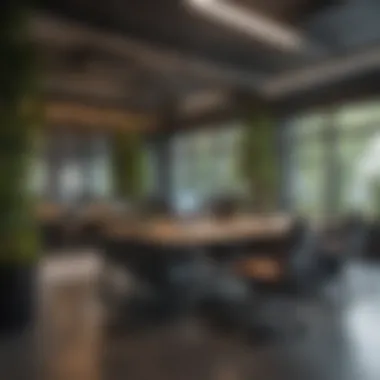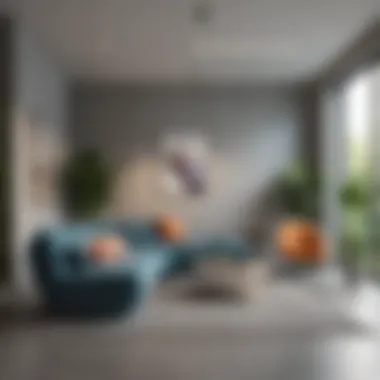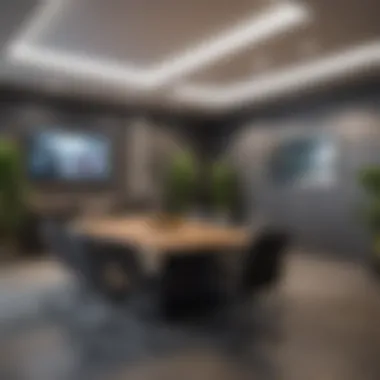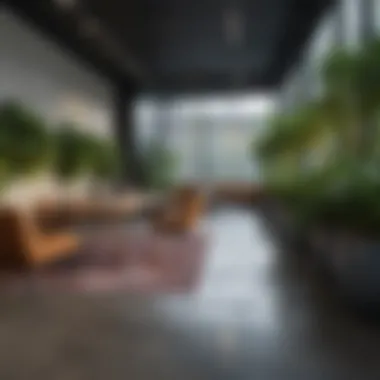Modern Office Inspiration for the Contemporary Workspace


Intro
The modern workspace reflects the shifting paradigms of how we interact with each other and our tasks. As more people embrace flexible work styles and remote arrangements, office designs must adapt not only to enhance productivity but also to promote well-being. The aim is to cultivate environments that foster collaboration while catering to the unique needs of all employees.
This article investigates various aspects of modern office design, encapsulating key elements such as trending styles, practical layouts, and the integration of technology. Understanding these factors is crucial for businesses and designers alike, allowing them to create spaces that are both functional and aesthetically pleasing, ultimately resulting in a more engaged workforce.
Design Inspiration
Trending Styles and Themes
An array of styles and themes have emerged in the landscape of office design. These reflect contemporary values such as sustainability, flexibility, and collaboration.
- Minimalism: Characterized by clean lines and uncluttered spaces, minimalism emphasizes functionality without excess. This style creates a calming environment, allowing employees to focus.
- Biophilic Design: This concept integrates natural elements into the workspace. Incorporating plants, natural light, and organic materials can invigorate spaces and contribute to employee well-being.
- Open-Plan Layouts: Open spaces encourage communication and teamwork. However, they must be balanced with areas for privacy and concentration.
Color Palettes and Combinations
Color plays a vital role in setting the mood of an office. Choosing the right combinations can enhance productivity and creativity. Here are popular choices:
- Cool Colors: Shades like blue and green promote tranquility and focus. These colors are excellent for areas intended for concentration.
- Warm Colors: Yellows and reds can inspire energy and enthusiasm. These hues work well in creative spaces or break rooms.
- Neutral Tones: Whites, greys, and beiges provide a versatile backdrop, allowing furniture and art pieces to stand out while maintaining a professional atmosphere.
"Colors not only influence emotions but also affect productivity levels in the workplace. Selecting the right color palette can positively impact employee motivation and collaboration."
Employers should analyze how color schemes can enhance the various areas of their office. A thoughtful approach leads to spaces that resonate with the needs of their occupants.
\
\
For further guidance, refer to articles on office design from resources like Wikipedia and Britannica.
Overview of Modern Office Design
Modern office design is essential in today's work environments. It reflects how space can influence productivity, collaboration, and overall employee satisfaction. As people spend a significant amount of time in office settings, the design of these spaces plays a critical role. Well-planned offices foster positive work atmospheres, promote creativity, and align with company culture.
The importance of modern office design involves several factors:
- Flexible Spaces: Companies benefit from adaptable environments that can accommodate various activities, from private work to team meetings.
- Health and Well-being: A well-designed workspace prioritizes employee well-being. Features like natural light, ventilation, and ergonomic furniture contribute to a healthy workplace.
- Brand Representation: The office design conveys a brand’s identity. It can showcase values, inspire employees, and attract clients.
- Increased Collaboration: Spaces that encourage collaboration can foster teamwork and innovation, leading to better outcomes.
- Sustainability: Modern designs also embrace eco-friendly principles, appealing to the growing number of environmentally conscious individuals.
A thorough understanding of modern office design can yield significant benefits for companies and individuals. A focus on aesthetics, functionality, and employee needs leads to inspired working environments.
Defining Modern Office Aesthetics
Modern office aesthetics goes beyond mere appearance. It encompasses the essence of the design elements used. Clean lines, minimalistic furniture, and thoughtful layouts characterize modern offices. The emphasis is often placed on open spaces, integrating natural elements, and using peaceful color palettes.
Key attributes of modern office aesthetics include:
- Functionality: Every design choice in a modern office serves a specific purpose and helps improve workflow.
- Minimalism: Reducing clutter and distractions is critical. This approach helps employees focus on their tasks effectively.
- Natural Elements: Incorporating plants and natural light elements can create calming environments. They help in reducing stress levels and boosting rejuvenation.
Understanding modern office aesthetics helps in creating spaces that are not only visually appealing but also enhance productivity and employee morale.
The Importance of Workspace Design
Workspace design significantly influences how individuals interact and share ideas. Effective design addresses the diverse needs of the workforce, adapting to different work styles. Poorly designed spaces can hinder communication and reduce motivation.
Some essential aspects of workspace design include:
- Encouraging Interaction: Collaborative spaces designed with comfort and connectivity in mind foster better communication.
- Supporting Concentration: Quiet zones within open floor plans allow focus and help manage noise, improving overall productivity.
- Personalization Opportunities: Allowing employees to customize their workspaces can enhance their ownership and connection to the environment.
The overall importance of workspace design aligns with an organization’s goals. It creates an adaptable and positive work environment that can meet the ever-evolving demands of the modern workforce.
"Design is not just what it looks like and feels like. Design is how it works." - Steve Jobs
This quote underlines the essential connection between aesthetics and functionality in office design.
Key Trends in Modern Offices
In the dynamic landscape of modern workplace design, identifying key trends plays a pivotal role. These trends not only reflect employee needs but also adapt to changes in technology and work patterns. Understanding these trends helps in conceptualizing workspaces that are both productive and engaging.


Open Concept Layouts
Open concept layouts represent a substantial shift from traditional office structures. They encourage communication and collaboration among employees. By removing barriers such as cubicles, a more fluid work environment emerges. This layout can enhance transparency and team cohesion. Moreover, the flexibility of the space allows for adjustments as team sizes and projects evolve.
Collaborative Spaces
Benefits of Collaborative Areas
Collaborative spaces offer employees the freedom to work together, fostering a stronger sense of community. These areas are designed for brainstorming and group projects. One primary characteristic of collaborative spaces is their multi-functionality. They can be used for informal meetings or creative sessions.
These spaces promote innovation and creativity, making their integration an attractive choice in modern offices. They provide an opportunity for spontaneous discussions that often lead to fresh ideas and solutions. However, it is crucial to ensure that the noise levels in these areas do not disrupt focused work.
Examples of Effective Designs
When viewing examples of effective designs, studies show that spaces equipped with movable furniture and adaptable layouts are particularly successful. These features allow for the quick transformation of environments to accommodate various group sizes and project requirements.
For instance, many companies now utilize modular furniture systems that encourage flexibility. This adaptability allows workplaces to evolve with employee and organizational needs. However, one must be cautious about over-engineering these spaces, as it can lead to confusion and inefficient use.
Private Workstations
Conversely, private workstations are essential for tasks requiring concentration. They provide employees with a reprieve from the bustle of collaborative areas. Having dedicated desks or enclosed spaces helps maintain privacy for sensitive tasks while still integrating elements from the open concept into their design. The key here is balance: fostering teamwork while respecting individual work requirements.
Color Psychology in Office Design
Color psychology plays a vital role in the modern workspace. It influences mood, productivity, and overall well-being of employees. Understanding how different colors evoke specific emotions helps in designing an effective office environment. For businesses aiming to enhance workplace productivity, color selection should not take a backseat. The ideal color palette can transform spaces, driving engagement and creativity.
Impact of Colors on Productivity
Research shows that colors significantly affect how employees perform at work. Bright colors, for instance, can energize spaces and enhance creativity. Blue tones are often associated with calmness, promoting focus and concentration. Cool colors help to reduce stress, while warmer tones can stimulate activity and communication. Thus, choosing the correct hues may increase efficiency and satisfaction within the workplace.
Color Schemes for Different Workspaces
Colors for Creative Spaces
Creative areas benefit from bold and vibrant colors. These hues can stimulate imagination and innovation. Using bright oranges or yellows in brainstorming rooms can inspire fresh ideas and collaboration. While these colors boost creativity, they must be balanced with calmer tones to prevent overstimulation. A well-rounded approach ensures a conducive environment for both brainstorming sessions and focused tasks, creating spaces that cater to the diverse needs of creatives.
Colors for Professional Environments
In contrast, professional settings often favor neutral colors like grays, whites, and muted blues. These palettes convey a sense of elegance and seriousness. Such colors help eliminate distractions, allowing employees to concentrate on their tasks. The key characteristic of these tones is their versatility; they work well in various settings, from formal offices to more relaxed workspaces. Neutral colors can also be accented with brighter accessories, maintaining professionalism while adding character.
Ergonomic Furniture Selection
Ergonomic furniture selection plays a crucial role in modern office spaces. With the increasing number of remote work and long office hours, the importance of selecting furniture that supports the body is paramount. Ergonomics focuses on designing workplaces that optimize comfort and efficiency. Incorporating ergonomic furniture can lead to significant benefits, such as reducing the risk of musculoskeletal disorders and enhancing overall productivity.
Importance of Ergonomics
Understanding the importance of ergonomics in the workspace is essential. Many employees spend hours seated at desks, which can lead to discomfort and long-term health issues. Proper ergonomic design promotes the natural alignment of the body, preventing strain and fatigue. The right ergonomic furniture can enhance comfort and encourage positive posture. As a result, employers may notice higher morale and lower healthcare costs associated with workplace injuries.
Types of Ergonomic Office Furniture
The selection of ergonomic office furniture includes various items that cater to different needs. Here are two prominent categories:
Adjustable Desks
Adjustable desks are a popular choice in modern workplaces. They allow users to alternate between sitting and standing throughout the day. This flexibility contributes to improved comfort and may even promote better focus. The key characteristic of adjustable desks is their height adjustment feature. By accommodating different body types, these desks prevent discomfort from prolonged sitting.
Moreover, adjustable desks can be tailored to individual preferences, making them a valuable addition to any office. However, a disadvantage might be that they require some investment compared to traditional desks. Nonetheless, the long-term benefits often outweigh the initial costs.
Supportive Chairs
Supportive chairs represent another essential type of ergonomic furniture. These chairs are designed to provide proper lumbar support, promoting healthy posture while seated. A notable feature is the ability to adjust the chair’s height, backrest, and armrests, which allows personalization for users.
Supportive chairs can significantly reduce physical strain, making them a beneficial choice for any office setting. They may be slightly more expensive than conventional chairs, but investing in quality can protect against future discomfort. Choosing supportive chairs can create a more pleasant working atmosphere.


Integrating Technology in the Workspace
In today’s fast-paced work environment, integrating technology into the workspace is crucial. Technology not only enhances productivity but also creates a more efficient and dynamic office. Companies are investing in modern solutions that streamline processes and improve employee satisfaction.
Smart Office Solutions
Smart office solutions are at the forefront of modern workplace design. These technologies foster connectivity and collaboration among team members. They include tools like IoT (Internet of Things) devices, smart lighting, and climate control systems.
- IoT devices can manage everything from office equipment to energy consumption. They provide real-time data that helps organizations make informed decisions.
- Smart lighting systems adjust automatically based on natural light levels, which can help to reduce energy costs.
- Temperature controls can ensure that workspaces remain comfortable, impacting employee morale and focus.
Implementing these solutions creates a more responsive and adaptable environment. Furthermore, they promote a culture of innovation.
Workplace Automation
Workplace automation is another important aspect of integrating technology into the workspace. Automation helps to minimize repetitive tasks, allowing employees to focus on more strategic initiatives. This can be done through tools like project management software, automated communication systems, and workflow optimization.
Benefits of workplace automation include:
- Increased efficiency in project management.
- Reduction in human error, leading to better results.
- Improved time management, allowing for greater focus on high-priority tasks.
One notable way to implement automation is through the use of software like Asana or Trello. These platforms help teams manage tasks seamlessly, fostering a collaborative work environment.
In summary, both smart office solutions and workplace automation contribute significantly to a modern workspace. By leveraging these technologies, offices become more than just a physical space; they evolve into a hub of productivity and innovation.
Biophilic Design Elements
Biophilic design elements focus on integrating nature into modern office environments. This approach recognizes the inherent connection humans have with nature and seeks to bring that connection indoors. As workspaces evolve, incorporating these elements can lead to not only improved aesthetics but also to enhanced well-being among employees. Spaces that resonate with nature tend to create calming atmospheres, reduce stress levels, and enhance overall productivity.
Benefits of Nature-Inspired Spaces
Nature-inspired spaces offer numerous advantages. Here are some notable benefits:
- Enhanced Well-Being: Access to natural light and views of greenery can improve mood and reduce anxiety.
- Increased Productivity: Studies show that environments rich in natural elements can boost focus and creativity.
- Better Air Quality: Plants can help purify the air by filtering toxins and increasing oxygen levels.
Thus, the inclusion of natural components into office design can manifest a significant positive impact on employees' physical and mental health, creating environments where they can thrive.
Incorporating Plants and Natural Light
Incorporating plants and natural light into the workplace can be approached in several ways:
- Plants as Decor: Select a variety of indoor plants that suit the office environment, such as succulents, ferns, or snake plants. These plants require minimal maintenance and can thrive in various lighting conditions.
- Daylight Optimization: Designing the office layout to maximize daylight is crucial. This can involve positioning workstations near windows or using glass walls to allow light to penetrate deeper into the space.
- Living Walls: Consider installing living walls. These vertical gardens can serve as stunning focal points while improving indoor air quality.
- Natural Materials: Use materials like wood and stone in furnishings and architecture. These elements bring a sense of warmth and connection to the outside world.
Ultimately, prioritizing plants and natural light creates an inviting atmosphere. Leveraging these features not only enhances the workplace but also fosters a deeper appreciation for the environment.
Personalization of Workspaces
Personalization of workspaces has become increasingly important in modern office design. It reflects the diverse needs of employees and the evolving nature of work itself. When people feel a sense of ownership over their environment, their productivity and job satisfaction tends to improve. This article focuses on the specific elements, benefits, and considerations involved in personalizing office spaces.
Employees spend a large portion of their day in the office. Therefore, a workspace that resonates with individual preferences can lead to a more comfortable and productive atmosphere. Some choices in personalization can include choosing decor, layout arrangements, or even assigning specific zones for tasks.
Allowing Employee Expression
One of the key aspects of workspace personalization is allowing employee expression. When employees personalize their areas, they are more likely to feel comfortable and motivated. This can be accomplished by allowing individuals to display personal items, artwork, or photographs that reflect their personalities. Such elements contribute not just to aesthetics, but also help foster emotional connections with the space.
By encouraging employees to express themselves, companies show that they value each person's individuality. This builds a sense of belonging, which can lead to enhanced collaboration and innovation. Here are a few methods to achieve this:
- Personal desks: Let employees customize their workstations with colors and decor.
- Flexible Art Displays: Have walls or bulletin boards for employees to showcase their creativity.
Customizing Shared Spaces
Customizing shared spaces is another significant aspect of creating a personalized workspace. In many modern office designs, open areas and communal spaces are common. These areas can often feel impersonal, leading to a less engaging environment. Therefore, modifying these shared areas according to the collective preferences of the employees is crucial.


When customizing shared spaces, consider the following elements:
- Theming: Choose a central theme that reflects the company's values while allowing input from employees.
- Collaborative Furniture: Use flexible and movable furniture to allow for different group activities and gatherings.
- Community Boards: Establish boards in common areas for posting achievements, upcoming events, or ideas.
"When employees have a say in the design of shared spaces, it encourages ownership and connection to the workplace."
Personalization not only enhances the working environment, but it also elevates the overall experience for employees. By investing thought into how spaces are formatted, organizations can create a more productive and satisfying atmosphere.
Sustainability in Office Design
Sustainability in office design is not just a trend; it's a necessity in today's environmentally conscious world. This section explores specific elements that contribute to sustainable workspace design. Choosing sustainable materials and ensuring energy efficiency are central to promoting environmental responsibility. These practices help reduce the overall carbon footprint of an office, making a significant impact on both the environment and employee well-being.
The benefits of incorporating sustainability include cost savings through improved energy efficiency and increased employee morale. When a workplace reflects eco-friendly values, it attracts talent who prioritize sustainability. As a result, businesses can cultivate a positive image and drive market differentiation.
Choosing Eco-Friendly Materials
When selecting materials for office spaces, several options stand out as environmentally friendly. Using materials that are recycled, reclaimed, or sustainably sourced is essential. This includes choosing products like bamboo flooring, which is renewable, or recycled metal and glass. These materials typically have lower environmental impact and provide longevity, making them ideal for office usage.
Other considerations in the selection process should focus on potential off-gassing. Materials that emit volatile organic compounds (VOCs) can negatively impact indoor air quality. Therefore, choosing low-VOC paint, finishes, and furnishings is highly recommended.
Eco-friendly materials can significantly influence the overall office aesthetic while supporting sustainability.
Energy Efficiency Considerations
Energy efficiency should be on any designer’s radar for modern offices. Simple solutions often bring great results. Implementing LED lighting systems is one major step. They consume much less energy and have a much longer lifespan compared to traditional bulbs.
Incorporating smart technology can also contribute to energy efficiency. For instance, smart thermostats allow for precise heating and cooling, adapting to occupancy patterns. Additionally, solar panels can be utilized whenever possible.
To further enhance energy efficiency, consider designs that maximize natural light. This approach not only reduces the need for artificial lighting but also improves employee mood and productivity.
Incorporating these elements makes an office not only more sustainable but enhances its attractiveness to environmentally conscious individuals and businesses.
Future Outlook of Office Spaces
The evolution of office spaces is a critical topic in today’s work environment. As companies adjust to changing conditions, assessing the future of office design offers vital insights into how spaces will function, what they will prioritize, and how they will support a diverse workforce. This section explores the impact of remote work trends and anticipates innovations that will shape office spaces moving forward.
Adapting to Remote Work Trends
The rise of remote work has undeniably transformed the traditional office model. Many organizations are now embracing flexible work arrangements. This includes hybrid models where employees split their time between home and the office.
- Collaborative Technology: Tools like Zoom and Slack have become essential. They enable seamless communication and collaboration among teams regardless of location. Integrating these platforms into the office layout encourages connectivity and inclusivity for all employees.
- Redesigning Space Requirements: Office designs are shifting towards creating more collaborative spaces rather than individual offices. Shared spaces accommodate team projects while offering areas for quiet focus. This duality allows for both collaboration and privacy as needed.
- Focus on Wellness: As work-life balance gains attention, offices are adapting with wellness spaces. These might include areas for breaks, quiet rooms, and even fitness options to enhance physical and mental well-being.
It's crucial for organizations to find adaptability in their spaces. The blend of remote and in-office work reshapes perceptions of what a modern office can be.
Innovations on the Horizon
Looking forward, several innovative trends are anticipated to emerge in office design. These may reshape the landscape of the workplace significantly.
- Bioadaptive Lighting: This technology adjusts artificial light based on the natural light available. This adapts to the time of day, promoting better mood and productivity among employees.
- Virtual Reality Environments: As VR technology becomes more accessible, training and meetings can take place in immersive environments. This enhances engagement and provides a fresh approach to traditional training methods.
- Smart Furniture: Furniture will continue to advance with technology. Desks equipped with sensors can adjust height based on user preferences or activity levels, supporting ergonomic needs.
- Focus on Sustainability: Future office spaces are likely to prioritize sustainable practices. This could mean using materials with low environmental impact or integrating energy-efficient systems. Companies recognizing their responsibility toward the environment will find value in sustainable designs.
The future is here, companies must adapt to survive and thrive in the new work landscape.
In summary, the outlook for office spaces is one of adaptability and innovation. Organizations must critically assess their designs to accommodate shifts in work styles and workforce needs. By embracing these trends, companies can create environments that foster productivity, collaboration, and well-being.
The End
In the realm of modern office design, the conclusion serves as a vital component that reiterates the significance of the discussed elements. This article emphasizes that the choices made in office layout, color schemes, and furniture selection are not mere aesthetic decisions; they are integral to enhancing employee satisfaction and productivity. The emphasis on creating spaces that foster collaboration and well-being cannot be overstated, as a well-designed office contributes to a more engaged workforce.
Summarizing Key Points
As we summarize the key points of this article, it is clear that several factors play a foundational role in modern office design:
- Layout Configuration: The open concept promotes openness, while private workstations allow for focused tasks.
- Color Psychology: Colors impact mood and productivity, guiding appropriate choices for various environments.
- Ergonomics: Selecting comfortable and functional furniture helps to prevent strain and injury.
- Technology Integration: Smart solutions and workplace automation enhance efficiency and connectedness.
- Biophilic Elements: Incorporating nature leads to better mental health and productivity.
- Personalization: Customized workspaces reflect individual employee personalities, fostering a sense of belonging.
Each point elaborates on the relevance of thoughtful design in forming an inspiring work environment.
Final Thoughts on Office Design
The future of office design is undeniably focused on adaptability and innovation. As the workforce evolves, professionals will need to consider new trends and the implications these have on employee success. Prioritizing a design that amplifies functionality and aesthetic appeal is necessary. Aspects such as sustainability must also be factored into future designs. The choices made today will lay the groundwork for tomorrow’s workspaces, leading to improved productivity and employee satisfaction.



